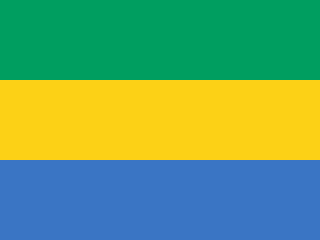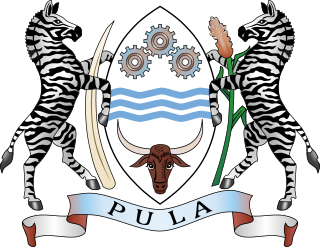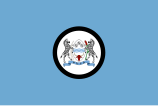
Botswana, officially the Republic of Botswana, is a landlocked country in Southern Africa. Botswana is topographically flat, with approximately 70 percent of its territory being the Kalahari Desert. It is bordered by South Africa to the south and southeast, Namibia to the west and north, and Zimbabwe to the northeast. It is connected by the Kazungula Bridge to Zambia, across the world's shortest border between two countries.
The Batswana, a term also used to denote all citizens of Botswana, refers to the country's major ethnic group. Prior to European contact, the Batswana lived as herders and farmers under tribal rule.

Mahikeng, formerly known as Mafikeng and alternatively known as Mafeking, is the capital city of the North West province of South Africa.

The national flag of the Principality of Liechtenstein consists of two horizontal bands, one blue and one red, charged with a gold crown in the canton. In use since 1764 and officially enshrined into the nation's constitution in 1921, it has been the flag of the principality since that year. The crown was added to the flag in 1937, after the country discovered at the Summer Olympics held the previous year that their flag was identical to the Haitian civil flag.

The national flag of Sierra Leone is a tricolour consisting of three horizontal green, white and blue bands. It was adopted in 1961, Sierra Leone's independence year, to replace the British Blue Ensign defaced with the arms of the Crown Colony of Sierra Leone.
"Fatshe leno la rona" is the national anthem of Botswana. The music was composed by Kgalemang Tumediso Motsete, who also authored the song's Setswana lyrics. It was adopted when the country became independent in 1966. Since independence, the song is sung occasionally during the country's important events such as Kgotla meetings, independence celebrations and other national events. The national anthem is highly respected to an extent that when it is sung movements are not allowed, people stand at attention, and security officers, like the police and soldiers, salute as a show of respect.

The pan-Slavic colors—blue, white and red—were defined by the Prague Slavic Congress, 1848, based on the symbolism of the colors of the flag of Russia, which was introduced in the late 17th century. Historically, many Slavic nations and states adopted flags and other national symbols that used some combination of those three colors. Slavic countries that use or have used the colors include Russia, Yugoslavia, Czechoslovakia, Czech Republic, Slovakia, Croatia, Serbia and Slovenia, whereas Belarus, Bosnia and Herzegovina, Bulgaria, Montenegro, North Macedonia, Poland and Ukraine use different color schemes.

Sir Seretse Goitsebeng Maphiri Khama, GCB, KBE was a Motswana politician who served as the first President of Botswana, a post he held from 1966 to his death in 1980.

The Bechuanaland Protectorate was a protectorate established on 31 March 1885 in Southern Africa by the United Kingdom. It became the Republic of Botswana on 30 September 1966.

The national flag of the Republic of the Congo consists of a yellow diagonal band divided diagonally from the lower hoist-side corner, with a green upper triangle and red lower triangle. Adopted in 1959 to replace the French Tricolour, it was the flag of the Republic of the Congo until 1970, when the People's Republic of the Congo was established. The new regime changed the flag to a red field with the coat of arms of the People's Republic in the canton. This version was utilized until the regime collapsed in 1991. The new government promptly restored the original pre-1970 flag.

The flag of Gabon is a tricolour consisting of three horizontal green, yellow and blue bands. Adopted in 1960 to replace the previous colonial flag containing the French Tricolour at the canton, it has been the flag of the Gabonese Republic since the country gained independence that year. The design of the present flag entailed the removal the Tricolour and the widening of the yellow stripe at the centre.

The flag of Saint Kitts and Nevis consists of a yellow-edged black band containing two white stars that divides diagonally from the lower hoist-side corner, with a green upper triangle and red lower triangle. Adopted in 1983 to replace the flag of Saint Christopher-Nevis-Anguilla, it has been the flag of the Federation of Saint Kitts and Nevis since the country gained independence that year. Although the flag utilises the colours of the Pan-Africanist movement, the symbolism behind them is interpreted differently. The three islands later became part of the West Indies Federation in 1958; after this dissolved four years later, they were granted the status of associate state as Saint Christopher-Nevis-Anguilla. However, Anguilla decided to secede from the federation in 1969, owing to fears that their population, which was already small, would be further marginalised in parliament. This was eventually formalised in 1980, and a new flag for the remaining parts of the federation was needed, since the symbolism of the previous flag centred on the concept of a union of three.

The flag of Solomon Islands consists of a thin yellow diagonal stripe from the lower hoist-side corner, with a blue upper triangle and green lower triangle, and the canton charged with five white stars. Adopted in 1977 to replace the British Blue Ensign defaced with the arms of the protectorate, it has been the flag of Solomon Islands since 18 November of that year, eight months before the country gained independence. Although the number of provinces has since increased, the number of stars on the flag that originally represented them remained unchanged.

The flag of Tanzania consists of a Gold-edged black diagonal band, divided diagonally from the lower hoist-side corner, with a green upper triangle and light blue lower triangle. Adopted in 1964 to replace the individual flags of Tanganyika and Zanzibar, it has been the flag of the United Republic of Tanzania since the two states merged that year. The design of the present flag incorporates the elements from the two former flags. It is one of a relatively small number of national flags incorporating a diagonal line, with other examples including the DR Congo, Republic of the Congo, Namibia, Trinidad and Tobago and Brunei.

The flag of The Gambia is the national flag of The Gambia. It consists of three horizontal red, blue and green bands separated by two thin white lines. Adopted in 1965 to replace the British Blue Ensign defaced with the arms of the Gambia Colony and Protectorate, it has been the flag of the Republic of the Gambia since the country gained independence that year. It remained unchanged throughout the Gambia's seven-year confederation with Senegal.

The coat of arms of Botswana was adopted on 25 January 1966. The centre shield is supported by two zebras. The shape of the shield is that of traditional shields found in Southern Africa. On the top portion of the shield are three cogwheels that represent industry.

The Botswana Police Service is the police service of Botswana and it is a part of Ministry of Defence, Justice and Security. The force has 9,500 police officers.
The Independence Day of Botswana, commonly called Boipuso, is a national holiday observed in Botswana on September 30 of every year. The date celebrates Botswana's Declaration of Independence from the United Kingdom on September 30, 1966.
The history of the Cinema of Botswana comprises film-making in the Southern African country of Botswana, both before and after Botswana's independence. The cinema of Botswana is one of a number of African national cinemas that also includes the national cinemas of Benin, Egypt, Kenya, Nigeria and South Africa, among others.

Batswana nationality law is regulated by the 1966 Constitution of Botswana, as amended; the Citizenship Act 1998, and its revisions; and international agreements entered into by the government of Botswana. These laws determine who is, or is eligible to be, a national of Botswana. The legal means to acquire nationality, formal legal membership in a nation, differ from the domestic relationship of rights and obligations between a national and the nation, known as citizenship. The Botswana nationality is typically obtained on the principle of jus sanguinis, i.e. by birth to parents with Botswana nationality. It can be granted to persons who have lived in the country for a specific period of time, who have performed distinguished service to the nation or who have an affiliation to the country through naturalisation.






















